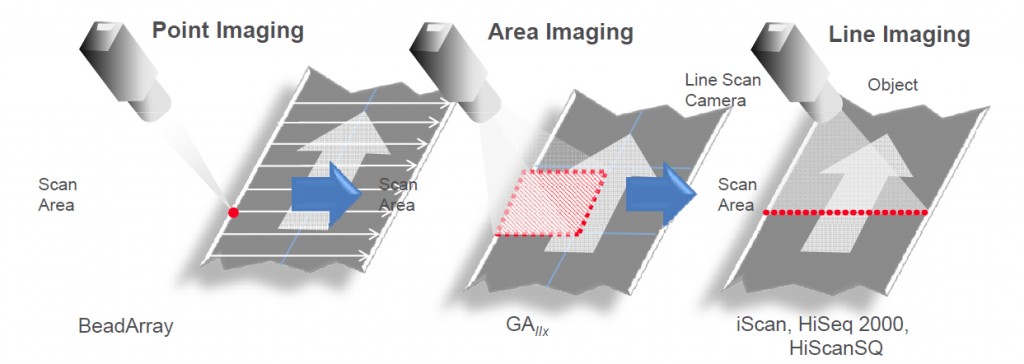 I’ve been wondering if there will be useful parts to be scavenged from HiSeq instruments when they reach the end of their lives. They have started showing up on Ebay but are still much too expensive to buy just for the sake of taking them apart.
I’ve been wondering if there will be useful parts to be scavenged from HiSeq instruments when they reach the end of their lives. They have started showing up on Ebay but are still much too expensive to buy just for the sake of taking them apart.
This 2010 presentation (downloaded from here), in addition to schematics of the imaging compartment (p. 49-50) and an overview of the sequencing chemistry, also contains a slide which shows that the next generation of instruments are based on line scanning cameras. This means that, while there may be other useful parts in the newer sequencers, if you are building an imaging system and need a camera like the Coolsnap K4 then the GAIIx is the system to get your hands on.
At the moment i have three HiSeq 200 here in the basement i’m allowed to salvage (crazy, but true). There are indeed useful parts inside. The setup is a line scanner not unlike the one to be seen in Illuina’s Patent DE 202011003570 U1 consisting of the two lasers (laserquantum ignis 660nm, gem 532nm with SMD6000 drivers) with filter revolvers, beam expander (Linos 2-8x) for each wavelength followed by a barrel lens, a cobiner to join the two excitation wavelengths, a piezo actuator for Z-Stage (Physik Instrumente P-601 with driver E-601 and E-801 Sensor module), Nikon CFI Plan APO VC 20x Objective. The Flow cells are moved by a XY-table (Parker, XR400 series i think, driven by a ViX driver module).
The fluorescence signal is divided by a fixed filter set in 4 channels and projected to 4 CCD-line-cameras (i’ve not hacked them yet, after some FPGA stages the data is collected by a Phoenix AS-PHX-D48CL Frame grabber card).
The instrument is more in-depth developed than the ABI Solids i hacked a year ago.
If you are interested in further information, pictures… send an email.
Hi Teide
Whats your e-mail address? I would really like to know a few more details about this optical bench.
Thanks
Ezequiel
I’ve sended a comment last week, now i acquired the missing informations and therefore sending the updated (and corrected) coment.
At the moment i have three HiSeq 2000 here in the basement i’m allowed to salvage (crazy, but true). There are indeed useful parts inside.
The setup is a line scanner not unlike the one to be seen in Illuina’s Patent DE 202011003570 U1 consisting of the two lasers (Laserquantum ignis 660nm, gem 532nm with SMD6000 drivers) with filter revolvers, beam expanders (Linos 2-8x) followed by a barrel lenses for each wavelength, a combiner to join the two excitation wavelengths, a piezo actuator for the Z-Stage (Physik Instrumente P-601 with driver E-601 and E-801 Sensor module) with mounted Nikon CFI Plan APO VC 20x Objective.
The flow cells are moved by a XY-table (Parker 803-4099, something like the XR400 series, driven by a ViX-250-IH driver module). The “Docking Station” with the Flowcells are mounted on three Stepper adjustable points to align them with the focal plane of the line scanner.
The fluorescence signal is divided by a fixed filter set in 4 channels and projected to 4 CCD cameras with S10405 line CCDs from Hamamatsu (DIL 40 package). Two Hamamatsu Camera Control Boards (Model C10000-509) are each controlling two of these line cameras. After a analogue stage the signals from the line CCDs are converted by 8 LTC2203 25Msps 16-Bit ADCs and processed by an Altera Cyclone II FPGA. Via a second board (by Illumina) housing a Spartan XC3S4000 FPGA and XC95288 CPLD (both Xilinx) the data is collected by the Phoenix AS-PHX-D48CL Frame grabber card in the Computer.
Also to mention is the very nice water-cooling system and high quality power supplies.
The instrument is more in-depth developed than the ABI Solids i hacked a year ago – but these used Firewire CCD cameras, Olympus microscopes and a complete IAI Tabletop Robot, ready for use in own experiments.
If you are interested in further information, pictures… send an email.
Teide Boysen